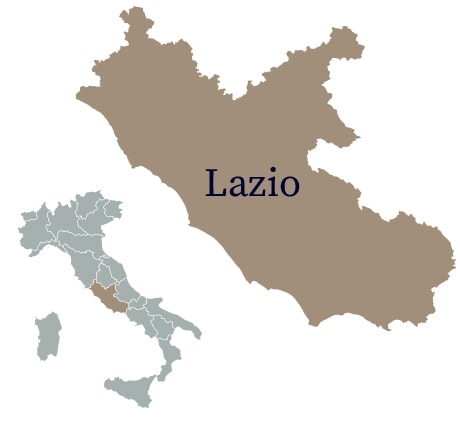
FOOD AND HISTORY
Once home to the capital of the Roman Empire, Lazio has long sat at a crossroads of cultures. Its cuisine is a testament to this history: humble dishes are rooted in the peasant community from Roman times; fresh local vegetables, fruit and other products have come from the fertile land; meanwhile other dishes are even influenced by Rome’s long-present Jewish population.
Indeed, meat of all sorts is prominently featured here — whether it’s beef, lamb or chicken — and all the parts, from oxtail to tongue and tripe. Lazio is, of course, a coastal region, which means seafood such as shellfish and even salt-cured cod (though it doesn’t actually come from the Mediterranean) make their way onto local plates too.
Lazio kitchens also turn out some of the country’s most well known pasta dishes, such as egg-, cheese- and bacon-topped spaghetti alla carbonara, or the ever-so-simple cheese-and-pepper cacio e pepe, or pasta all’amatriciana with its ingredients of pecorino, tomato and guanciale (cured pork cheek). Other favorites include gnocchi alla romana, and sugo all’arrabbiata (meaning “angry” sauce), which is named after the hot peperoncino flakes that will surely have you in a fluster.
The region’s fertile land gifts it with a bounty of fresh ingredients such as artichokes, strawberries, chestnuts, legumes, and more. And with those products other tasty creations are made like extra virgin olive oil, sheep’s milk pecorino, buffalo mozzarella, Roman ricotta cheese, and classic dishes such as carciofi alla giudia (“Jewish-style” artichokes, which are deep-fried to delicious perfection).
Meals are finished off with a range of local treats such as the cream-filled pastries called maritozzi, or crostata di ricotta, a jam and cheese tart that has its origins in Rome’s famous Jewish quarter.
Best known for being home to the Italian capital, Rome, Lazio is becoming increasingly noted for its wine production. One of the region’s most impressive wines is Cesanese Piglio, a ruby-colored red that features very fruity scents, especially cherry, and has a full-bodied, dry and smooth texture. This wine can be drunk young, when it is especially crisp, or also aged.
Another promising red is Aleatico di Gradoli, which is produced in northern Lazio, not far from the town of Viterbo. Also ruby red in color, it has rich aromas of violet, red fruit, and even jam, and is soft, fragrant and has a long finish. The sweet version is also impressive — it’s produced by leaving the grapes to dry for a few weeks on traditional racks, thus concentrating their sugar and flavors.
Among white wines, Frascati Superiore stands out. It’s made from Malvasia and Trebbiano grapes, and has aromas of white and yellow flowers, and fresh fruit. Expect similar characteristics from other regional white wines produced in Castelli Romani, Est! Est! Est!!! di Montefiascone (yes, that’s the name of the wine zone!), and Orvieto, which can be produced both in the southern part of Umbria and in northern Lazio.

FOOD AND HISTORY
Once home to the capital of the Roman Empire, Lazio has long sat at a crossroads of cultures. Its cuisine is a testament to this history: humble dishes are rooted in the peasant community from Roman times; fresh local vegetables, fruit and other products have come from the fertile land; meanwhile other dishes are even influenced by Rome’s long-present Jewish population.
Indeed, meat of all sorts is prominently featured here — whether it’s beef, lamb or chicken — and all the parts, from oxtail to tongue and tripe. Lazio is, of course, a coastal region, which means seafood such as shellfish and even salt-cured cod (though it doesn’t actually come from the Mediterranean) make their way onto local plates too.
Lazio kitchens also turn out some of the country’s most well known pasta dishes, such as egg-, cheese- and bacon-topped spaghetti alla carbonara, or the ever-so-simple cheese-and-pepper cacio e pepe, or pasta all’amatriciana with its ingredients of pecorino, tomato and guanciale (cured pork cheek). Other favorites include gnocchi alla romana, and sugo all’arrabbiata (meaning “angry” sauce), which is named after the hot peperoncino flakes that will surely have you in a fluster.
The region’s fertile land gifts it with a bounty of fresh ingredients such as artichokes, strawberries, chestnuts, legumes, and more. And with those products other tasty creations are made like extra virgin olive oil, sheep’s milk pecorino, buffalo mozzarella, Roman ricotta cheese, and classic dishes such as carciofi alla giudia (“Jewish-style” artichokes, which are deep-fried to delicious perfection).
Meals are finished off with a range of local treats such as the cream-filled pastries called maritozzi, or crostata di ricotta, a jam and cheese tart that has its origins in Rome’s famous Jewish quarter.
Best known for being home to the Italian capital, Rome, Lazio is becoming increasingly noted for its wine production. One of the region’s most impressive wines is Cesanese Piglio, a ruby-colored red that features very fruity scents, especially cherry, and has a full-bodied, dry and smooth texture. This wine can be drunk young, when it is especially crisp, or also aged.
Another promising red is Aleatico di Gradoli, which is produced in northern Lazio, not far from the town of Viterbo. Also ruby red in color, it has rich aromas of violet, red fruit, and even jam, and is soft, fragrant and has a long finish. The sweet version is also impressive — it’s produced by leaving the grapes to dry for a few weeks on traditional racks, thus concentrating their sugar and flavors.
Among white wines, Frascati Superiore stands out. It’s made from Malvasia and Trebbiano grapes, and has aromas of white and yellow flowers, and fresh fruit. Expect similar characteristics from other regional white wines produced in Castelli Romani, Est! Est! Est!!! di Montefiascone (yes, that’s the name of the wine zone!), and Orvieto, which can be produced both in the southern part of Umbria and in northern Lazio.